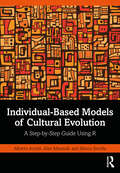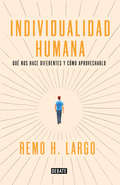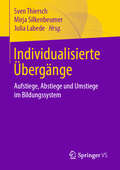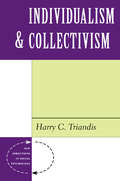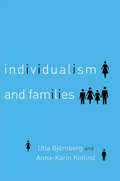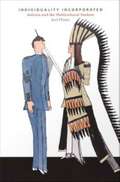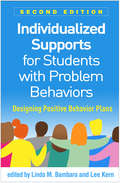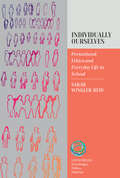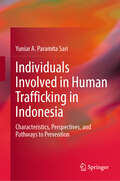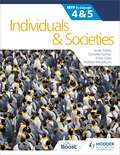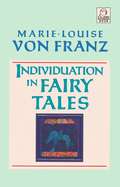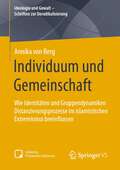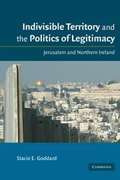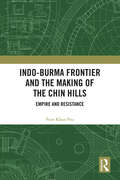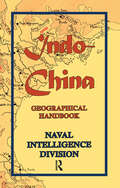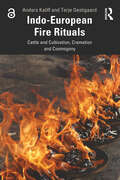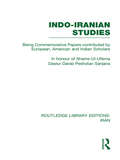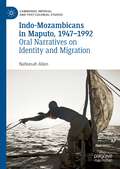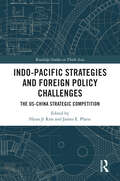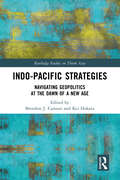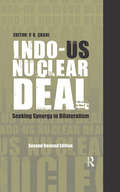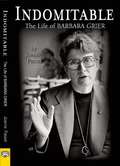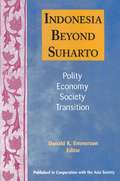- Table View
- List View
Individual-Based Models of Cultural Evolution: A Step-by-Step Guide Using R
by Alex Mesoudi Alberto Acerbi Marco SmollaIndividual-Based Models of Cultural Evolution shows readers how to create individual-based models of cultural evolution using the programming language R. The field of cultural evolution has emerged in the last few decades as a thriving, interdisciplinary effort to understand cultural change and cultural diversity within an evolutionary framework and using evolutionary tools, concepts, and methods. Given its roots in evolutionary biology, much of cultural evolution is grounded in, or inspired by, formal models. Yet many researchers interested in cultural evolution come from backgrounds that lack training in formal modelling, such as psychology, anthropology or archaeology. This book addresses that gap. It provides example code in R for readers to run their own models, moving from very simple models of the basic processes of cultural evolution, such as biased transmission and cultural mutation, to more advanced topics such as the evolution of social learning, demographic effects, and social network analysis. Features of this book: Recreates existing models in the literature to show how these were created and to enable readers to have a better understanding of their significance and how to apply them to their own research questions Provides full R code to realize models and analyse and plot outputs, with line-by-line analysis Requires no previous knowledge of the field of cultural evolution, and only very basic programming knowledge This is an essential resource for researchers and students interested in cultural evolution, including disciplines such as psychology, anthropology, archaeology, and biology as well as sociology and digital humanities.
Individualidad humana: Qué nos hace diferentes y cómo aprovecharlo
by Remo H. LargoA lo largo de su vida, Remo H. Largo ha centrado sus investigaciones en el desarrollo humano. En Individualidad humana. Qué nos hace diferentes y cómo aprovecharlo y cómo aprovecharlo reúne todos sus resultados para ofrecernos una descripción iluminadora, transversal e integradora de la individualidad humana. Albert Einstein dijo que, si juzgáramos a un pez por su habilidad de escalar un árbol, viviría su vida entera creyendo ser estúpido. Remo H. Largo lleva más de cuarenta años estudiando el desarrollo humano y hoy más que nunca sigue constatando el enorme desafío que implica llevar una vida en armonía con las características particulares de cada persona desde el nacimiento hasta la vejez. Para el pediatra suizo, las capacidades humanas se van configurando a lo largo del tiempo de manera completamente diferente según las necesidades de cada individuo, determinando en gran medida la manera en que se vaa vivir y el sentido que cada persona otorgará a su vida. Pero en las sociedades modernas dominadas por la economía y la optimización, predomina la insensata idea de que todos somos iguales y podemos lograr los mismos objetivos, frustrando el desarrollo individual a expensas de expectativas ajenas. Así pues, partiendo de las singularidades de cada individuo Remo H. Largo aboga en esta fascinante investigación por asumir y comprender nuestra diversidad no solo como el fundamento de la evolución misma, sino también como la propia base de nuestra existencia.
Individualisierte Übergänge: Aufstiege, Abstiege und Umstiege im Bildungssystem
by Julia Labede Sven Thiersch Mirja SilkenbeumerDer vorliegende Band widmet sich der Frage, wie Auf-, Ab- und Umstiege im Bildungssystem organisiert sind, in verschiedenen Entwicklungsphasen und Sozialisationsräumen zustande kommen und von den Akteuren gedeutet werden. Diese Bildungsverläufe sind erst ansatzweise erforscht und diskutiert worden. In der Schul- und Bildungsforschung orientiert man sich nach wie vor stark an Normal(bildungs)laufbahnen und fokussiert die institutionell normierten Übergänge, um Bildungsbeteiligung, Bildungserfolg und soziale Bildungsungleichheiten zu untersuchen. Die Beiträge dieses Buches stellen demgegenüber unterschiedliche Theoriepositionen und aktuelle Ergebnisse zu den Dynamiken und Prozessen der Aneignung und Bewältigung individualisierter Übergänge dar. In diesem Zusammenhang werden Herausforderungen für die Bildungsforschung und Fragen zur pädagogischen Gestaltung dieser Übergangsformen formuliert.
Individualism and Collectivism: Theory, Method, And Applications (New Directions in Social Psychology #Vol. 18)
by Harry C Triandis<p>In this, his latest book, Harry Triandis explores the constructs of collectivism and individualism. Collectivists are closely linked individuals who view themselves primarily as parts of a whole, be it a family, a network of co-workers, a tribe, or a nation. Such people are mainly motivated by the norms and duties imposed by the collective entity. Individualists are motivated by their own preferences, needs, and rights, giving priority to personal rather than to group goals.Reviewing relevant literature in philosophy, political science, anthropology, sociology, and psychology, Triandis shows how culture shapes the way we think; and he also explores the wide-ranging implications of individualism and collectivism for political, social, religious, and economic life. He makes compelling arguments for the appreciation of both perspectives, drawing on examples from Japan, Sweden, China, Greece, Russia, the United States and other countries. <p>Triandis challenges the view that psychology is universal, offering evidence for culture-specific influences on thought and action. We learn that the cultural patterns represented by individualism and collectivism lead people to view their worlds through different lenses, attaching different meanings to life events. Triandis explains how these variations in meaning can help us better understand why crime rates, divorce rates, levels of self-esteem, feelings of well-being, and indeed overall behavioral patterns can be so different from one society to another.
Individualism and Families: Equality, Autonomy and Togetherness
by Ulla Bjornberg Anna-Karin KollindAlmost all women and men claim that gender equality within their relationships is the ideal. In practice, however, equality is not predominant within many couples and families. This book develops current debates about individualisation within families – particularly how partners understand and resolve tensions between the need for togetherness and personal autonomy, and how partners view and work with increasing gender equality. Individualism and Families is based on a large Swedish study from two of the foremost European experts on the sociology of the family. The study looks particularly at partnering, parenting, intimacy, commitments, attitudes to finances and gender divisions of labour.
Individuality Incorporated: Indians and the Multicultural Modern
by Joel PfisterSpanning the 1870s to the present, Individuality Incorporated demonstrates how crucial a knowledge of Native American-White history is to rethinking key issues in American studies, cultural studies, and the history of subjectivity. Joel Pfister proposes an ingenious critical and historical reinterpretation of constructions of "Indians" and "individuals. " Native Americans have long contemplated the irony that the government used its schools to coerce children from diverse tribes to view themselves first as "Indians"--encoded as the evolutionary problem--and then as "individuals"--defined as the civilized industrial solution. As Luther Standing Bear, Charles Eastman, and Black Elk attest, tribal cultures had their own complex ways of imagining, enhancing, motivating, and performing the self that did not conform to federal blueprints labeled "individuality. " Enlarging the scope of this history of "individuality," Pfister elaborates the implications of state, corporate, and aesthetic experiments that moved beyond the tactics of an older melting pot hegemony to impose a modern protomulticultural rule on Natives. The argument focuses on the famous Carlisle Indian School; assimilationist novels; Native literature and cultural critique from Zitkala-Sa to Leslie Marmon Silko; Taos and Santa Fe bohemians (Mabel Dodge Luhan, D. H. Lawrence, Mary Austin); multicultural modernisms (Fred Kabotie, Oliver La Farge, John Sloan, D'Arcy McNickle); the Southwestern tourism industry's development of corporate multiculturalism; the diversity management schemes that John Collier implemented as head of the Indian New Deal; and early formulations of ethnic studies. Pfister's unique analysis moves from Gilded Age incorporations of individuality to postmodern incorporations of multicultural reworkings of individuality to unpack what is at stake in producing subjectivity in World America.
Individualized Supports for Students with Problem Behaviors, Second Edition: Designing Positive Behavior Plans (The\guilford School Practitioner Ser.)
by Linda M. Bambara Lee KernNoted for providing everything needed to develop individualized positive behavior support (PBS) plans for students with pervasive behavioral challenges, this authoritative guide has been revised and expanded to reflect 15 years of changes in the field. The book walks practitioners through the PBS process, emphasizing a team-based approach and presenting assessment procedures, intervention strategies, and guiding questions. Detailed case examples illustrate ways to meet the diverse needs of students across abilities, grade levels (PreK–12), and problem behaviors. In a convenient large-size format, the book follows the sequence of a typical PBS course, making it ideal for use in teaching and training. New to This Edition *Incorporates current tools and practices within an expanded, whole-school PBS approach. *Chapters on multi-tiered systems of support and the fundamentals of classroom management. *Chapter on writing, monitoring, and evaluating a complete PBS plan. *Two extended case examples that run through many of the chapters. *&“Commentaries from the Field&” in which leading experts reflect on the contributions, challenges, and future directions of PBS.
Individually Ourselves: Personhood, Ethics, and Everyday Life in School (Lifeworlds: Knowledges, Politics, Histories #2)
by Sarah Winkler-ReidDrawing on ethnographic fieldwork in a London high school, Individually Ourselves demonstrates how young people elaborate notions of individual personhood through their friendships, and pervasive peer ethics, shaped in and through relations of power and inequality. By examining the interplay between ourselves and others during such a formative time of life, the book addresses how individuality is produced in everyday life and how our interactions help create the person we become.
Individuals Involved in Human Trafficking in Indonesia: Characteristics, Perspectives, and Pathways to Prevention
by Yuniar A. SariThis book delves into the complex world of human trafficking in Indonesia, focusing on individuals involved in trafficking for domestic labor and the sex industry. It shifts the emphasis from victims to perpetrators, exploring the motivations and socio-cultural factors that drive people to participate in these crimes. Through a thorough analysis of court documents and expert interviews, the book uncovers the backgrounds and methods of traffickers, offering a nuanced perspective on this critical issue. Addressing gaps in current international and national policies, this book proposes practical recommendations for preventing trafficking by understanding the perspectives of those who commit it. This work aims to deepen the reader's understanding of trafficking in Indonesia and provide actionable insights for combating this global problem.
Individuals and Societies for the IB MYP 4&5: MYP by Concept
by Danielle Farmer Emily Giles Kenneth A Dailey Robbie WoodburnDevelop your skills to become an inquiring learner; ensure you navigate the MYP framework with confidence using a concept-driven and assessment-focused approach to Individuals and societies, presented in global contexts.· Develop conceptual understanding with key MYP concepts and related concepts at the heart of each chapter. · Learn by asking questions for a statement of inquiry in each chapter. · Prepare for every aspect of assessment using support and tasks designed by experienced educators.· Understand how to extend your learning through research projects and interdisciplinary opportunities.· Think internationally with chapters and concepts set in global contexts.
Individuals and Societies for the IB MYP 4&5: MYP by Concept
by Danielle Farmer Emily Giles Kenneth A Dailey Robbie WoodburnDevelop your skills to become an inquiring learner; ensure you navigate the MYP framework with confidence using a concept-driven and assessment-focused approach to Individuals and societies, presented in global contexts.· Develop conceptual understanding with key MYP concepts and related concepts at the heart of each chapter. · Learn by asking questions for a statement of inquiry in each chapter. · Prepare for every aspect of assessment using support and tasks designed by experienced educators.· Understand how to extend your learning through research projects and interdisciplinary opportunities.· Think internationally with chapters and concepts set in global contexts.
Individuation in Fairy Tales: Revised Edition
by Marie-Louise von FranzWith a text revised and corrected by the author, this definitive edition of Individuation in Fairy Tales is rich with insights from religion, literature, and myth. Dr. von Franz focuses on the symbolism of the bird motif in six fairy tales of Europe and Asia: "The White Parrot" (Spain), "The Bath Bagerd" (Persia), "Princess Hassan Pasha" (Turkestan), "The Bid Flower Triller" (Iran), "The Nightingale Giser" (Balkans), and "The Bird Wehmus" (Austria). She explores the themes of psychological and spiritual transformation in the varied images of birds, such as the phoenix, the parrot, and the griffin. Special attention is given to the connection between fairy tales and alchemy and to the guidance that fairy tales give to therapeutic work.
Individuum und Gemeinschaft: Wie Identitäten und Gruppendynamiken Distanzierungsprozesse im islamistischen Extremismus beeinflussen (Ideologie und Gewalt - Schriften zur Deradikalisierung)
by Annika von BergIn der Extremismusforschung herrscht wenig Konsens darüber, was genau Distanzierungs- und Ausstiegsprozesse ausmacht. Was jedoch feststeht, ist, dass es nicht „den einen“ Weg aus dem Extremismus gibt. Mit diesem Theoriemodell wird angestrebt, die zahlreichen Wege aus dem Extremismus in einem Theoriegerüst zusammenzufassen und dabei einen Aspekt ganz besonders zu fokussieren: Die Rolle von Identität und Gruppendynamiken.Während sich der erste Teil der Publikation mit der Entwicklung der theoretischen Grundlage beschäftigt, beschreibt der zweite Teil die Anwendung der entwickelten theoretischen Grundlage auf Menschen, die ihren Weg aus dem religiös begründeten Extremismus gefunden haben.Insgesamt lässt sich erkennen, dass Gruppendynamiken eine zentrale Rolle in der Entscheidung, sich von extremistischen Einstellungen und Handlungsweisen zu distanzieren, spielen. Verschiedene Identitäten sind hierbei ebenfalls ein ausschlaggebender Faktor für eine Distanzierung, mehr noch: sie sind wichtig für eine langfristige und nachhaltige Abkehr vom Extremismus.
Indivisible Territory and the Politics of Legitimacy
by Stacie E. GoddardIn Jerusalem and Northern Ireland, territorial disputes have often seemed indivisible, unable to be solved through negotiation, and prone to violence and war.
Indo-Burma Frontier and the Making of the Chin Hills: Empire and Resistance
by Pum Khan PauThis book examines the British colonial expansion in the so-called unadministered hill tracts of the Indo-Burma frontier and the change of colonial policy from non-intervention to intervention. The book begins with the end of the First Anglo-Burmese War (1824–26), which resulted in the British annexation of the North-Eastern Frontier of Bengal and the extension of its sway over the Arakan and Manipur frontiers, and closes with the separation of Burma from India in 1937. The volume documents the resistance of the indigenous hill peoples to colonial penetration; administrative policies such as disarmament; subjugation of the local chiefs under a colonial legal framework and its impact; standardisation of ‘Chin’ as an ethnic category for the fragmented tribes and sub-tribes; and the creation and consolidation of the Chin Hills District as a political entity to provide an extensive account of British relations with the indigenous Chin/Zo community from 1824 to 1935. By situating these within the larger context of British imperial policy, the book makes a critical analysis of the British approach towards the Indo-Burma frontier. With its coverage of key archival sources and literature, this book will interest scholars and researchers in modern Indian history, military history, colonial history, British history, South Asian history and Southeast Asian history.
Indo-China
by NavalFirst published in 2007. Routledge is an imprint of Taylor & Francis, an informa company.
Indo-European Fire Rituals: Cattle and Cultivation, Cremation and Cosmogony
by Terje Oestigaard Anders KaliffIndo-European Fire Rituals is a comparative study of Indo-European fire rituals from modern folklore and ethnography in Scandinavia and archaeological material in Europe from the Bronze Age onwards to the Vedic origins of cosmos in India and today’s cremations on open pyres in Hinduism. Exploring Indo-European fire rituals and sacrifices throughout history and fire in its fundamental role in rites and religious practices, this book analyses fire rituals as the unifying structure in time and space in Indo-European cultures from the Bronze Age onwards. It asks the question how and why was fire the ultimate power in culture and cosmology? Fire as an agent and divinity was fundamental in all major sacrifices. In Europe, ritual fires in relation to agriculture and fertility may also explain the enigma of cremation. Cremated remains were ground and used in fertility rituals, and ancestral fires played an essential role in metallurgy and the creation of cosmos. Thus, the role of fire rituals in culture and cosmology enables a unique understanding of historic developmental processes. For students and academics studying Indo-European culture history from the Bronze Age onwards, this book has a broad interdisciplinary audience including archaeology, ethnography, folklore, religious and Indo-European studies.
Indo-European Fire Rituals: Cattle and Cultivation, Cremation and Cosmogony
by Terje Oestigaard Anders KaliffIndo-European Fire Rituals is a comparative study of Indo-European fire rituals from modern folklore and ethnography in Scandinavia and archaeological material in Europe from the Bronze Age onwards to the Vedic origins of cosmos in India and today’s cremations on open pyres in Hinduism.Exploring Indo-European fire rituals and sacrifices throughout history and fire in its fundamental role in rites and religious practices, this book analyses fire rituals as the unifying structure in time and space in Indo-European cultures from the Bronze Age onwards. It asks the question how and why was fire the ultimate power in culture and cosmology? Fire as an agent and divinity was fundamental in all major sacrifices. In Europe, ritual fires in relation to agriculture and fertility may also explain the enigma of cremation. Cremated remains were ground and used in fertility rituals, and ancestral fires played an essential role in metallurgy and the creation of cosmos. Thus, the role of fire rituals in culture and cosmology enables a unique understanding of historic developmental processes.For students and academics studying Indo-European culture history from the Bronze Age onwards, this book has a broad interdisciplinary audience including archaeology, ethnography, folklore, religious and Indo-European studies.The Open Access version of this book, available at http://www.taylorfrancis.com, has been made available under a Creative Commons Attribution-Non Commercial-No Derivatives (CC BY-NC-ND) 4.0 license.
Indo-Iranian Studies: Being Commemorative Papers contributed by European, American and Indian Scholars (Routledge Library Editions: Iran)
by VariousThroughout his life the Shams-ul-Ullema devoted himself to advancing the Zoroastrian Faith, not only as a priest and teacher, but also as a writer. This volume of papers is authored by an international group of scholars and covers the history, philosophy, literature and language of Persia and the Indo-Iranians.
Indo-Mozambicans in Maputo, 1947-1992: Oral Narratives on Identity and Migration (Cambridge Imperial and Post-Colonial Studies)
by Nafeesah AllenThis book explores the experiences of ‘Indo-Mozambicans,’ citizens and residents of Mozambique who can trace their origins to the Indian subcontinent, a region affected by competing colonialisms during the twentieth century. Drawing from ethnographic interviews, the author illustrates why migration developed as both an identity marker and a survival tool for Indo-Mozambicans living in Maputo, in response to the series of independence movements and prolonged period of geo-political uncertainty that extended from 1947 to 1992. A unique examination of post-colonialism, the book argues that four pivotal moments in history forced migratory patterns and ethnic identity formations to emerge among Indo-Mozambicans, namely, the end of the British empire in India and the subsequent partition of India and Pakistan in 1947; the end of the Portuguese empire in India, with the annexation of Goa, Daman and Diu in 1961; the independence of Mozambique from Portugal in 1975; and the civil war of Mozambique from 1977 to 1992. Framing these historical markers as trigger points for shifts in migration and identity formation, this book demonstrates the layered experiences of people subject to Portuguese colonialism and highlights the important perspective of those ‘left behind’ in migration studies.
Indo-Pacific Strategies and Foreign Policy Challenges: The US-China Strategic Competition (Routledge Studies on Think Asia)
by Hyun Ji Rim and James E. PlatteThis book examines key issue areas of Indo-Pacific strategies such as cyber security, space security, maritime security, emerging technologies, and institutional frameworks in the context of deepening US–China rivalry. With greater interconnectedness across various fields, the Indo-Pacific region faces greater security challenges including future strategic power competition. States are increasingly engaging in intense strategic activities and strengthening partnerships. The first part of book focuses on the strategic competition between the United States and China in different areas including cyber security, space security, maritime security, emerging technologies, and institutional frameworks. The second part of the book presents the perspectives of different local actors in the regional theatre and the intentions and concepts behind their growing interconnectedness under Indo-Pacific strategies, including China, Russia, Taiwan, Hong Kong, and North Korea. Through examining different aspects of US–Indo-Pacific strategy, this edited book contributes to a better understanding of Indo-Pacific strategy and its implications for broader security cooperation in a more interconnected world. The book will be of interest to scholars and policy makers working on Asian Security, Politics, International Relations, and the security dynamics of East Asia and the Indo-Pacific.
Indo-Pacific Strategies: Navigating Geopolitics at the Dawn of a New Age (Routledge Studies on Think Asia)
by Brendon J. CannonThis book focuses on the Indo-Pacific region’s growing prominence as the world’s major powers gravitate toward this space to expand their influence. With dynamic shifts taking place in the globe’s most strategically volatile region, Indo-Pacific Strategies aims at clarifying the geopolitics of the Indo-Pacific, expounded both as a strategic concept and nascent region, thus contributing to the burgeoning policy and academic debate. The book offers indispensable insights and appropriate remedies to maintain the rules-based international order as threatened by China’s increasingly assertive and bellicose posturing. It offers up-to-date analyses of Covid-19-related geopolitical trends, the strategies of various Indo-Pacific states against the backdrop of great power competition, the increasingly confrontational stance of Indo-Pacific states against China and the 2020 US election results. This unique book presents deep insights into the roles of Eurasia, small island states, the Middle East and Africa, in addition to Australia, India, Japan and the US, thereby providing much needed comparative studies. It also closely investigates the strategic and tactical operationalization of the Indo-Pacific, making it an essential read for scholars, policymakers, students, and strategists in the field of international politics and Area Studies. Excerpt from the foreword by ABE Shinzō, (former) Prime Minister of Japan"I think this book is the timeliest attempt to bring together the wisdom of eleven people to present a multifaceted view of the FOIP [Free and Open Indo-Pacific]. As a reader, I would like to express my gratitude to the editors and contributors for their valuable intellectual contributions."
Indo-US Nuclear Deal: Seeking Synergy in Bilateralism
by P. R. ChariThis book interrogates the Indo-US civil nuclear agreement from its inception in July 2005 to its conclusion in the latter part of 2008 through 12 articles, each of which focuses on different aspects of the deal. They discuss the factors that facilitated the deal, the roadblocks that were encountered, and the implications of the deal for the future of India’s foreign policy, its energy security and the international non-proliferation regime. Together, they address the internal political dynamics in India and the United States in order to present perspectives of both countries.
Indomitable: The Life of Barbara Grier
by Joanne Passet"Whatever else will be said about her--and you can bet there will be plenty, because Barbara was no stranger to controversy--the one thing that is true above all else is that she was the most important person in lesbian publishing in the world. Without her boldness and her audacity, there might not be the robust lesbian publishing industry there is today. ” --Teresa DeCrescenzo Barbara Grier--feminist, activist, publisher, and archivist--was many things to different people. Perhaps most well known as one of the founders of Naiad Press, Barbara’s unapologetic drive to make sure that lesbians everywhere had access to books with stories that reflected their lives in positive ways was legendary. Barbara changed the lives of thousands of women in her lifetime. For the first time, historian Joanne Passet uncovers the controversial and often polarizing life of this firebrand editor and publisher with new and never before published letters, interviews, and other personal material from Grier’s own papers. Passet takes readers behind the scenes of The Ladder, offering a rare window onto the isolated and bereft lives lesbians experienced before the feminist movement and during the earliest days of gay political organizing. Through extensive letters between Grier and her friend novelist Jane Rule, Passet offers a virtual diary of this dramatic and repressive era. Passet also looks at Grier’s infamous "theft” of The Ladder’s mailing list, which in turn allowed her to launch and promote Naiad Press, the groundbreaking women’s publishing company she founded with partner Donna McBride in 1973. Naiad went on to become one of the leaders in gay and lesbian book publishing and for years helped sustain lesbian and feminist bookstores--and readers--across the country. JOANNE PASSET is Professor of History Emerita at Indiana University East. Her previous books include Sex Variant Woman: The Life of Jeannette Howard Foster, Sex Radicals and the Quest for Women's Equality, Cultural Crusaders: Women Librarians in the American West, and Aspirations and Mentoring in an Academic Environment (with Mary Niles Maack).
Indonesia Beyond Suharto
by Donald K. EmmersonThis text presents an accessible introduction to the most significant problems facing Indonesia and raises issues for further investigations. It addresses such questions as: how has Indonesia managed to remain one country?; and is there a truly national Indonesian culture?
